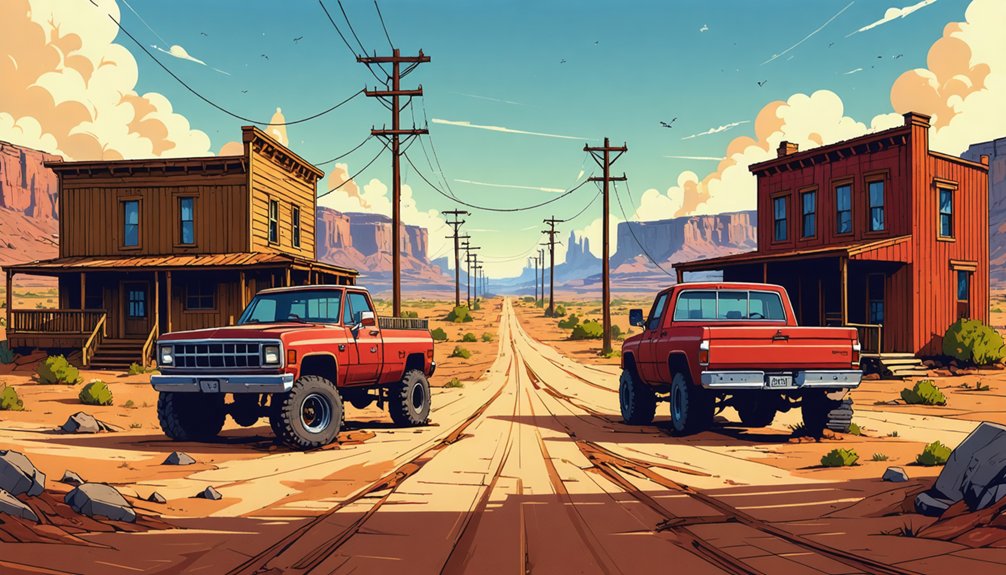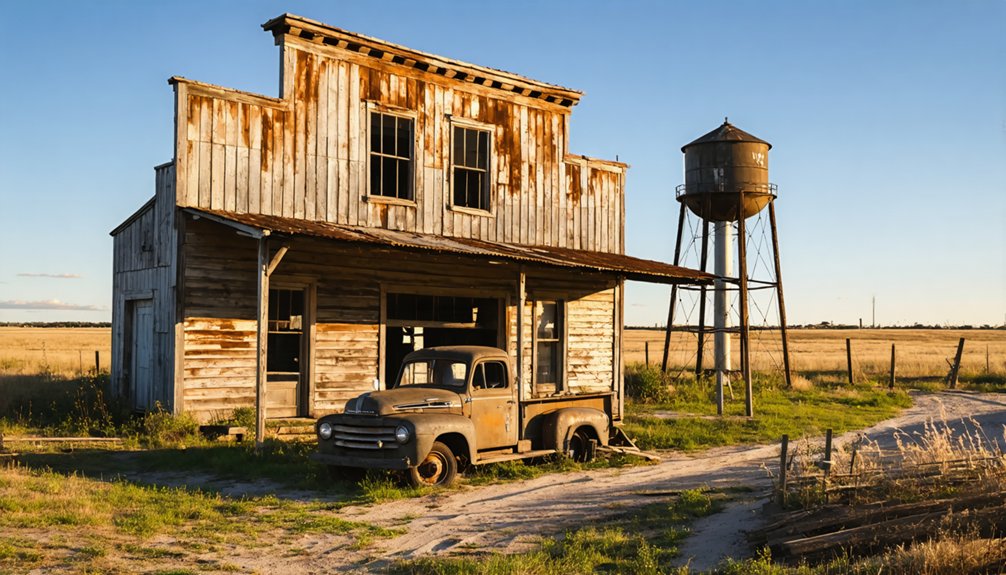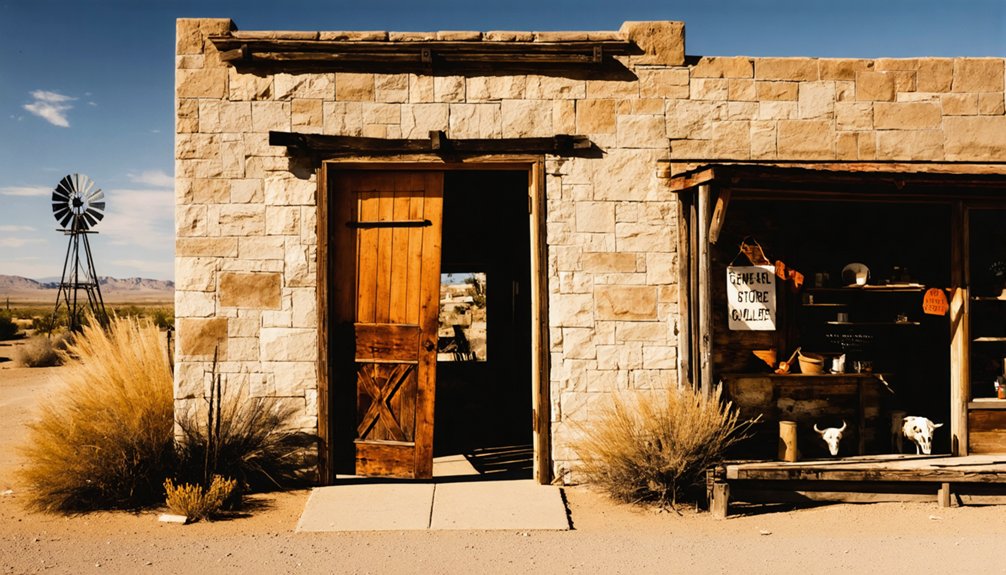You’ll find Canyon Valley’s ghost town remnants near Palo Duro Canyon, where James A. Shoemaker founded this isolated settlement in 1925. The community thrived briefly through cotton farming, with its Valley Gin processing over 2,000 bales during its peak in 1934. Poor transportation access and economic challenges led to its abandonment by the 1970s. Today, only scattered foundations remain on private property, telling a story that mirrors many vanished Texas farming towns.
Key Takeaways
- Canyon Valley was established in 1925 under James A. Shoemaker’s leadership, becoming a thriving agricultural community southwest of Palo Duro Canyon.
- The town’s economy centered around cotton production, with Valley Gin processing 2,230 bales during its peak year in 1934.
- Geographic isolation and poor transportation infrastructure, including only one unpaved road, significantly hindered the town’s development and sustainability.
- Economic decline occurred post-1950 due to cotton industry mechanization, the Dust Bowl’s effects, and younger residents seeking opportunities elsewhere.
- Today, Canyon Valley exists as a ghost town with only scattered foundations and deteriorating ruins, largely inaccessible due to private property.
The Birth of a Prairie Settlement
While the high plains of the Texas Panhandle remained largely untamed in the late 1880s, Canyon Valley emerged as a promising settlement southwest of Palo Duro Canyon.
You’ll find its roots in Lincoln Guy Conner’s December 1887 survey, where he established a dugout that served as his home, store, and post office – laying the foundation for what would become Canyon City. Much like the first settlers who arrived by covered wagon in the 1850s to establish farming communities, early residents were drawn by the area’s abundant resources.
The settlement’s prairie identity took shape when A.L. Hammond suggested naming it after the nearby canyon, reflecting the untamed landscape that surrounded it.
By spring 1889, the town’s layout was complete, and mule-drawn wagons hauled lumber from distant Quanah to build the first structures. A blacksmith shop opened as one of the earliest businesses, providing essential services to the growing community.
Determined settlers endured long hauls from Quanah by mule-drawn wagon, bringing lumber to shape Canyon City’s first buildings.
As Randall County’s newly designated county seat in July 1889, Canyon City marked its place on the map, transforming from raw prairie to a burgeoning frontier community.
Early Years and Community Development
Unlike its predecessor Canyon City, the Canyon Valley settlement emerged much later in 1925 under James A. Shoemaker’s leadership, showcasing the pioneer spirit of early Texas settlers.
You’ll find the community’s resilience reflected in their swift establishment of a one-room schoolhouse in 1926, which they expanded to two rooms by 1928 as student numbers grew. Similar to safe river crossings, the settlement’s strategic location helped establish its early foothold.
Despite challenging geography and limited access via a single unpaved road, Canyon Valley’s early years saw determined growth. Like many of the 511 ghost towns across Texas, Canyon Valley faced the common struggles of isolation and limited resources.
The Valley Gin served as a crucial hub for local farmers, while the school’s peak enrollment of 66 students in 1934 marked the community’s height.
Yet you’d have noticed the settlement’s isolation below the Caprock and difficult transportation routes ultimately constrained its development, foreshadowing the changes that would come in later decades.
Agricultural Legacy and Economic Foundation
You’ll find Canyon Valley’s agricultural roots firmly established in its cotton production, with the Valley Gin processing an impressive 2,230 bales during its peak year in 1934.
The gin served as an essential economic hub for local farm families who relied on cotton cultivation alongside their other agricultural pursuits.
Despite the region’s primary focus on cattle ranching, cotton farming played a significant role in diversifying the local economy and helping families weather the economic challenges of the early 20th century. Following the U.S. annexation of Texas in 1845, many farmers and ranchers benefited from the distribution of lands which enabled them to establish diverse agricultural operations.
Like many settlements in the area, the community faced hardships from recurring severe droughts that tested the resilience of early settlers.
Cotton Farming Hub
Before Canyon Valley emerged as a bustling cotton hub in the early 1930s, Texas cotton farming had already established deep roots dating back to Spanish missions in the 18th century.
You’d find cotton cultivation thriving along the fertile river-bottom soil between the Brazos and Colorado Rivers, where Stephen F. Austin’s settlers had introduced advanced agricultural practices.
The introduction of barbed wire in the 1870s helped stimulate significant growth in the cotton industry across Texas.
Hard-working families relied on tenant farming to make a living, with share tenants and sharecroppers working the land in exchange for a portion of the crop yield.
Valley Gin Operations
The Valley Gin emerged as a cornerstone of Canyon Valley’s agricultural development when C.F. Flemins and Doyl Thornhill partnered to establish the facility in 1957. They strategically purchased 17 acres from S.G. Appling, constructing a modern gin that would serve local cotton farmers for decades.
You’ll find the gin’s technological innovations reflected the era’s rapid modernization, featuring pneumatic systems and mechanical processing that dramatically increased efficiency over manual methods. The facility’s design incorporated pneumatic tube transport pioneered by Robert Munger.
By 1977, Flemins had become the sole owner, operating the last remaining business in the area. The gin’s processing innovations transformed raw cotton into market-ready bales while managing valuable byproducts like cotton seed for replanting and livestock feed.
As the community’s economic anchor, Valley Gin provided essential market access for farmers and sustained the local economy through seasonal employment and commerce. Like the nearby Mt. Blanco cotton gin, it represented one of the final operational businesses in a declining rural community.
Local Farm Families
Pioneer farmer James A. Shoemaker founded Canyon Valley in 1925, establishing a three-room homestead that marked the beginning of rich family traditions in this rugged Texas territory.
You’ll find that early farming families acquired up to 5,000 acres through state-authorized purchases, developing agricultural practices suited to the semi-arid environment.
These resilient families balanced crop cultivation with livestock raising, adapting to market demands and environmental challenges.
The Valley Gin’s production of 2,200 cotton bales in 1934 reflects their agricultural success, despite facing the Spanish Flu pandemic, Great Depression, and recurring droughts.
While many homesteads were eventually abandoned by mid-century, those who persisted shaped Canyon Valley’s legacy through diverse farming operations and cattle ranching, though their numbers gradually declined as land ownership patterns shifted toward consolidation.
Transportation Challenges and Isolation

Located within a deeply eroded valley of the Salt Fork Brazos River, Canyon Valley’s geographic isolation posed significant transportation challenges that ultimately contributed to its demise.
You’d find just one unpaved road serving the entire town, featuring a low water crossing that frequently became impassable during wet weather. The town’s transportation history reflects the harsh realities of its location below the Caprock escarpment, which complicated road construction and maintenance efforts.
While Texas State Highway 207 lay merely 3 miles west, accessibility issues plagued the community, as you’d have to navigate 25 miles to reach the nearest town of Ralls. These limitations severely impacted trade, emergency services, and daily life, driving many residents away and deterring new settlers from establishing roots.
The Decline of Canyon Valley
Canyon Valley’s post-1950 economy crumbled as the cotton industry’s mechanization eliminated jobs and the Dust Bowl’s lingering effects made farming less viable.
You’ll find that the town’s isolation and poor transportation connections to major markets prevented any meaningful economic diversification or recovery efforts.
The combination of agricultural decline, limited access, and younger residents moving away for better opportunities ultimately sealed Canyon Valley’s fate as another lost Texas town.
Economic Impact Post-1950
As post-World War II mechanization swept through rural Texas, Canyon Valley’s economic significance began to crumble under mounting pressures. The dramatic economic shifts transformed the agricultural landscape, forcing small farms to consolidate into large agribusinesses.
You’d have witnessed a perfect storm of decline as demographic trends showed younger residents fleeing to urban areas for better opportunities.
Without significant oil discoveries to offset agricultural losses, Canyon Valley faced these devastating changes:
- Essential services vanished as schools and the post office closed by the 1970s
- Local businesses shuttered, creating a downward spiral of job losses
- Property values plummeted while buildings fell into disrepair
The town’s tax base eroded, making it impossible to maintain infrastructure, ultimately cementing Canyon Valley’s fate as another Texas ghost town.
Transportation Barriers Limit Growth
The rugged terrain and harsh desert landscape of southern Crosby County played a defining role in Canyon Valley’s ultimate demise.
You’ll find that the town’s isolation, intensified by low-level river valleys and mountain ranges, made transportation infrastructure development nearly impossible.
While Canyon Valley initially benefited from nearby railroad lines, it was later bypassed by major rail expansions and highways.
You won’t see any remnants of direct rail stops, which severely limited the town’s economic viability.
The lack of reliable transportation options crippled the movement of agricultural products and livestock – the region’s economic backbone.
Without proper road networks or rail connections, Canyon Valley couldn’t adapt to technological shifts.
The community’s youth left for more accessible towns, businesses closed, and the once-promising settlement gradually transformed into a ghost town.
Cotton Industry Fades Away
Once thriving cotton fields surrounding Canyon Valley fell victim to devastating boll weevil infestations in the 1920s, marking the beginning of the area’s agricultural decline.
You’ll find this pest impact wasn’t the only factor driving Canyon Valley’s cotton decline – broader economic shifts and transportation challenges sealed its fate.
Key factors that accelerated the cotton industry’s demise:
- Soil depletion from years of intensive farming made it impossible to maintain profitable yields.
- Lack of local processing facilities and cotton warehouses forced farmers to accept lower prices.
- Limited rail access put Canyon Valley at a competitive disadvantage against better-connected cotton hubs like Lubbock.
Without the infrastructure to compete in modernizing markets, Canyon Valley’s cotton industry couldn’t survive the combined pressures of pest problems, the Great Depression, and competition from synthetic fibers.
Remnants and Physical Structures Today
Modern-day Canyon Valley stands as a stark example of Texas’s most thoroughly abandoned ghost towns, with virtually no intact structures remaining on site. If you’re interested in remnant exploration, you’ll find only scattered foundations and deteriorating building ruins typical of neglected locations.
Decades of harsh weather, natural disasters, and abandonment have accelerated the decay documentation of what little remains. Unlike other Texas ghost towns that still feature standing cotton gins or country stores, Canyon Valley’s physical traces have largely vanished.
You’ll encounter difficulty accessing the site, as it’s situated on private property with few visible markers or maintained roads. The weathered foundations and occasional rubble you might discover serve as the last evidence to this once-thriving community, now claimed by time and the elements.
Historical Impact on Rural Texas

While physical remnants of Canyon Valley have largely disappeared, its story exemplifies a broader pattern of rural transformation across Texas during the 20th century.
You’ll find that Canyon Valley’s cultural heritage mirrors the challenges many rural communities faced as they struggled to maintain their identity against mounting economic pressures.
- The town’s peak enrollment of 66 students in 1934 reflected a brief period of community resilience before mechanization and urban migration changed rural life forever.
- Your understanding of rural Texas history deepens when you see how Canyon Valley’s isolation, without paved roads, ultimately sealed its fate.
- You’re witnessing, through Canyon Valley’s story, how transportation access became the lifeline determining which rural communities would survive and which would fade away.
Preservation Status and Site Access
Like many Texas ghost towns suffering from decades of neglect, Canyon Valley’s preservation status remains largely undefined, with limited documentation of its remaining structures or formal conservation efforts.
You’ll find preservation efforts hampered by complex ownership issues and harsh environmental conditions that accelerate structural decay. Without utilities or maintained infrastructure, the site faces significant restoration challenges.
The absence of coordinated preservation initiatives leaves existing structures vulnerable to further deterioration and vandalism.
Site accessibility remains restricted, as you’ll need to navigate unclear property boundaries and potential private ownership restrictions.
If you’re planning to visit, be aware that Canyon Valley likely requires proper permissions and possibly off-road vehicles to access. Remember to respect any posted restrictions and practice leave-no-trace principles to help protect what remains of this historic site.
Frequently Asked Questions
Were There Any Notable Crimes or Lawlessness During Canyon Valley’s Existence?
You won’t find documented crime statistics or law enforcement records showing notable lawlessness in this remote farming community, where limited access and strong social ties helped maintain peaceful daily life.
What Indigenous Tribes Originally Inhabited the Area Before Canyon Valley’s Establishment?
Like shadows on the plains, you’ll find the Comanche were the dominant Native tribe in this territory, with Kiowa and Apache peoples also sharing historical significance in the region’s story.
Did Any Famous or Historically Significant People Ever Visit Canyon Valley?
You won’t find any famous visitors or historically significant people connected to Canyon Valley in the records. The town’s remote location and limited infrastructure kept it isolated from notable personalities.
What Natural Disasters or Severe Weather Events Impacted Canyon Valley?
You’ll find recurring floods damaged the low water crossing and drought impacted local agriculture and the Valley Gin’s closure. While regional tornadoes were common, there’s no record of direct strikes on the settlement.
Were There Any Local Legends or Folklore Associated With Canyon Valley?
You won’t find documented ghost stories or local myths specific to Canyon Valley, though nearby ghost towns like Tascosa and Plemons share tales of haunted gunfights and horses that detected quicksand.
References
- https://mix941kmxj.com/the-strange-sad-story-of-a-texas-ghost-town-youll-never-visit/
- https://discovertexasoutdoors.com/places/canyon-valley/
- https://kids.kiddle.co/Canyon_Valley
- https://www.texasescapes.com/TexasGhostTowns/Gray-Mule-Texas.htm
- https://en.wikipedia.org/wiki/List_of_ghost_towns_in_Texas
- https://www.youtube.com/watch?v=viPRQm2SSY0
- https://www.tshaonline.org/handbook/entries/canyon-tx-randall-county
- https://www.coppercanyon-tx.org/residents/pages/copper-canyon-history
- https://www.thestoryoftexas.com/discover/texas-history-timeline
- https://www.thc.texas.gov/public/upload/publications/red-river-war.pdf



